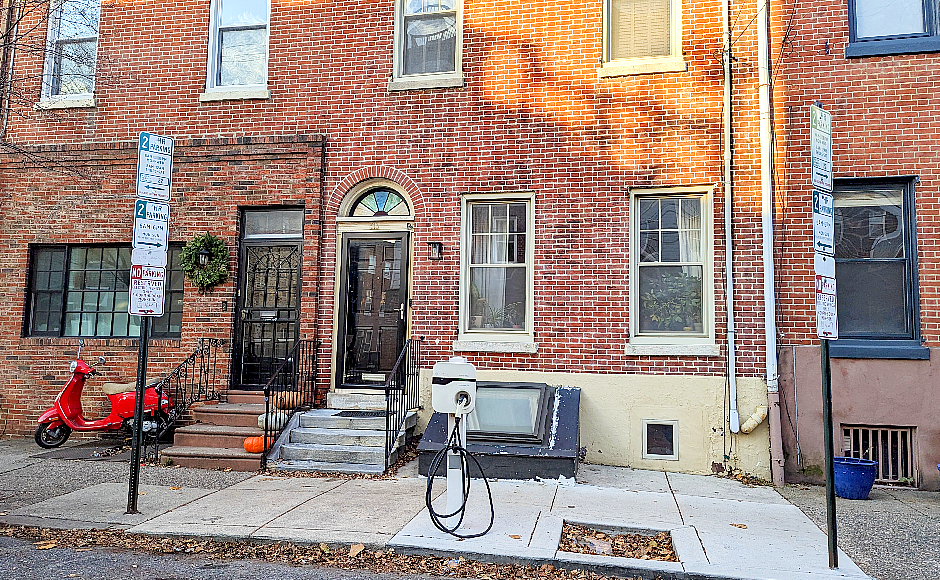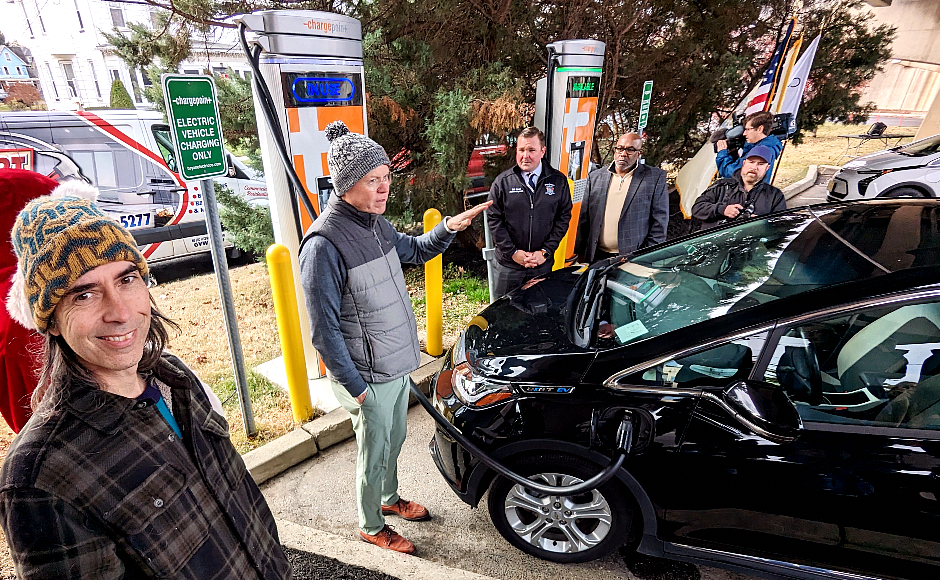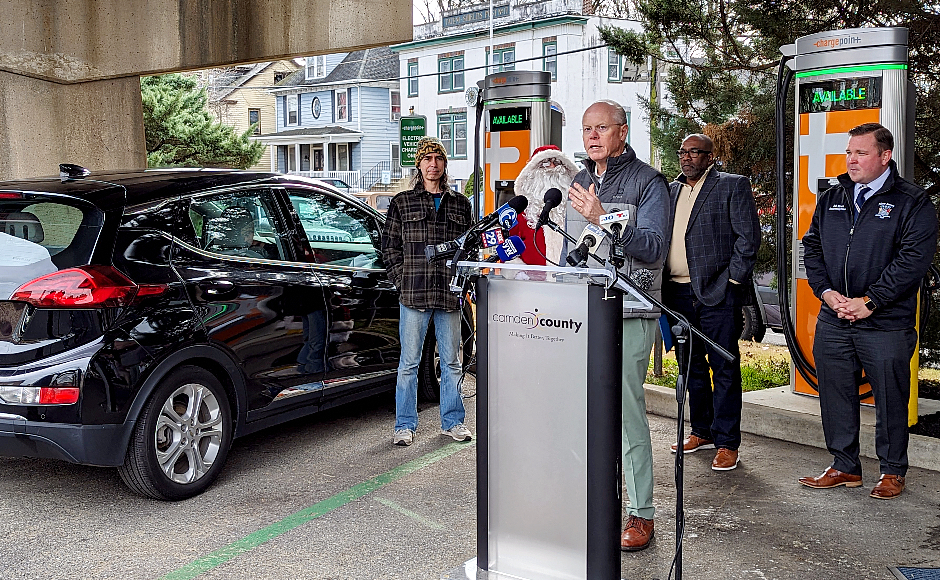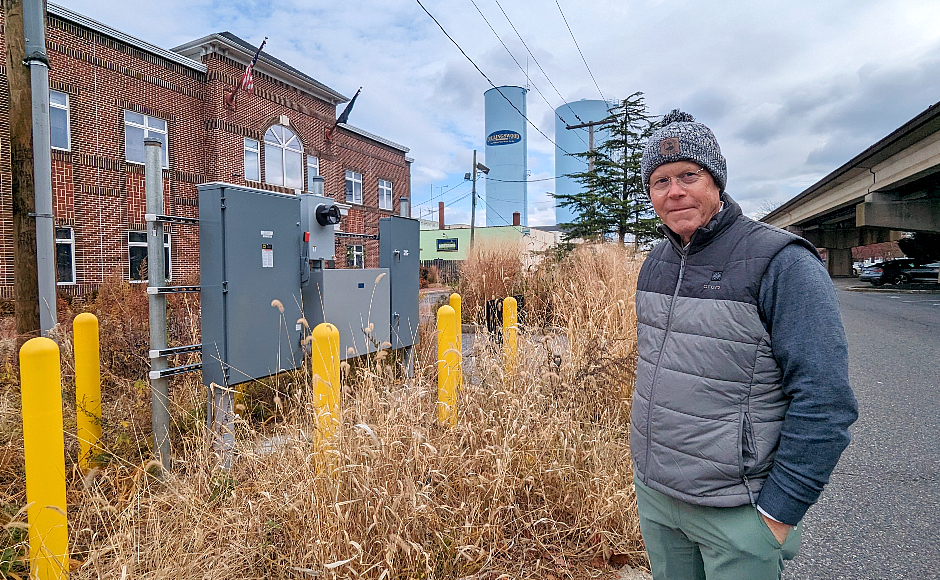The infrastructure was funded by $250,000 in grants from state agencies and public utilities, and more will be needed to support a target of 330,000 electric vehicles on New Jersey roads by 2025.
By Matt Skoufalos | December 11, 2023
New Jersey drivers don’t pump their own gas, but in Collingswood, electric vehicle (EV) owners may now begin plugging in their cars at a pair of public charging stations in the borough downtown.
Last week, officials ceremonially cut the ribbon on a pair of ChargePoint charging stations in the 600 block of North Atlantic Avenue, the first to be unveiled in Collingswood, with a third unit nearby in the public garage at the Lumberyard apartments.
The stations, which Collingswood Mayor Jim Maley said were constructed with $250,000 in grants awarded by the state Board of Public Utilities (NJBPU), Department of Environmental Protections (NJDEP), and energy provider PSE&G.
“This has been a long time coming,” Maley said, crediting borough employees and Sustainable Collingswood volunteers with their efforts to source the funds and technical assistance required to facilitate the installation of the stations.
The project, which took months to complete, includes the charging stations themselves as well as the electrical infrastructure that regulates power to them.
Prior to their installation, Maley said borough staff found EV owners running charging cables to their vehicles in odd places around town — even within the same lot, at power boxes traditionally reserved for vendors at the Collingswood Farmers Market. The mayor said such incidents helped frame the scope of demand for dedicated stations in the community.
“Doing this at this scale hits home,” Maley said. “It’s about finding a location that works, that you think is somewhat accessible; visible, but out of the way. Infrastructure is the hardest piece of this.”
New Jersey Assemblyman Bill Moen (D, NJ-05), who also serves as vice-chair of the Assembly Transportation and Independent Authorities Committee, spoke at the ribbon-cutting about the New Jersey Energy Master Plan goal of “100 percent clean energy by 2050,” and what EVs mean to achieving that benchmark.
“We’re underneath PATCO, talking about EV chargers, with Bike Share just across the way,” Moen said, referring to the multimodal travel options to which Collingswood already boasts access.
“One of the goals of state government is to have 330,000 electric vehicles in New Jersey by 2025.”
Those EVs will require places to recharge their batteries, and Camden County — home to the only county-government-level department of sustainability in the state — has 22 public charging stations as of last year, said Camden County Commissioner Jonathan Young.
The county was also the first to debut zero-emissions NJ Transit buses last summer, as the agency works to fully electrify its fleet by 2040.
Collingswood resident Chris DiPinto, who showcased his 2017 Chevy Bolt EV at the charging station ribbon-cutting, said user demand for charging infrastructure is only increasing.
Mostly DiPinto uses the Bolt to commute to his guitar shop in Philadelphia, but he’s driven as far as 300 miles on a single charge; about as far as the Catskills in New York. Navigating among charging stations changes the way the family takes road trips, but they use the Plugshare app to get to the next battery top-up.
In some cases, that means waiting an hour or more outside of a hotel or big-box store, occasionally with little else to explore in the meantime. (The appeal of situating the charging stations in the Collingswood downtown is meant as an incentive to shop and dine nearby, Maley said.)
The electricity isn’t provided for free — it costs about $11 to get the Bolt battery to an 80-percent charge — nor is it always generated in a sustainable fashion. DiPinto typically charges his vehicle at his home in the borough, which is powered by solar energy, but until the state generates fully its electricity from renewable energy sources, the charging stations are connected to an electrical grid powered by fossil fuels.

A neighborhood EV charging spot in a block of row homes in South Philadelphia. Credit: Matt Skoufalos.
However, DiPinto said he’s never stopped for gas, nor has the wear and tear on the vehicle been comparable to that of a combustion-engine car.
He’s replaced the car’s batteries twice under warranty, and changed the strut covers and tires, but that’s about the extent of the maintenance he’s performed on the vehicle.
“Committing to this method of travel doesn’t bother us,” DiPinto said.
“If you’re going to save the planet, there’s going to be some inconvenience. I think it’s the way of the future.”
With electric vehicle sales hitting a milestone of more than 1 million sold in the first 11 months of 2023, he’s not alone. Supporting their use on American highways will require a significant expansion of the public charging grid. Soon enough, municipalities like Collingswood won’t be the only places to find stations like those unveiled last Tuesday, but it will take even more public and private financial incentives to create that infrastructure.
“It’s going to take a lot to help us,” Maley said. “This is a big issue.”






